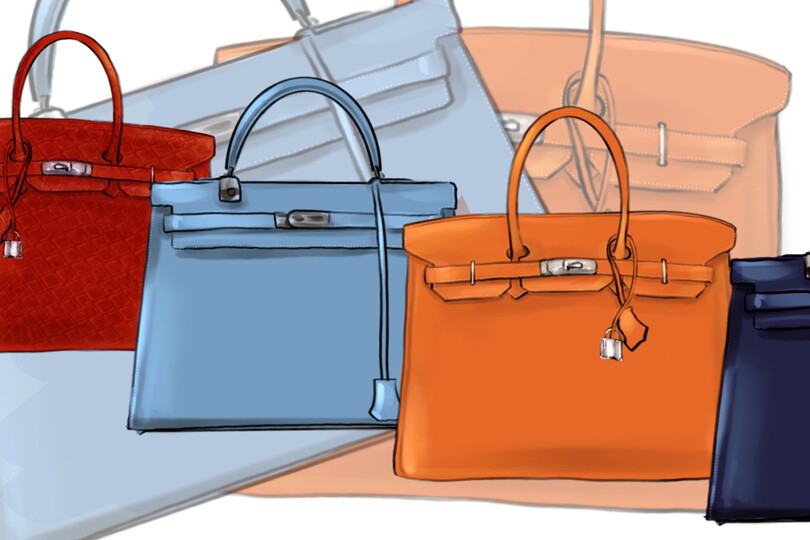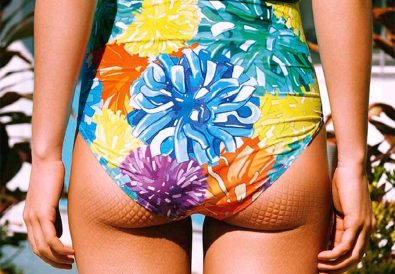Part of an ongoing series of 29Secrets stories, taking a deep dive into the history of legendary beauty products and iconic fashion and pop culture moments…
By Christopher Turner
Illustration by Michael Hak
The Hermès Birkin bag is the quintessential fashion accessory. The luxury bag isn’t the only highly coveted style from the legendary French fashion house, but it is recognized as a symbol of wealth and the ultimate status symbol in the arm-candy stakes due to its high price and assumed long waiting lists. Drake collects them for his future wife. Kate Moss once used them as diaper bags. The Kardashians have amassed an impressive collection of Birkins between them. Kanye West gifted Kim Kardashian a one-of-a-kind Birkin featuring a painting by contemporary artist George Condo in 2013, while the couple’s daughter North has been spotted carrying a white mini Birkin. Victoria Beckham is rumoured to own over 100 of them. Did we mention the starting price in 2021 was around $13,000 CAD, while bags made of exotic animal skin and precious metals have sold for nearly half a million dollars at auction in recent years? Some even say that the Birkin bag is a better investment than gold or the stock market, and its exclusivity has led to a thriving resale market.
But how did the Birkin bag become so coveted as the most sought-after item in the high-end fashion industry? Here’s the story behind the bag’s creation and how its existence was a happy accident, borne out of an exchange between former Hermès chief executive Jean-Louis Dumas and Paris-based British actress Jane Birkin during an Air France flight in the early ’80s.
![]()
The history of Hermès
First, a little history on the family-owned fashion house. In 1837, Thierry Hermès founded his eponymous business in Paris as a horse harness shop, dedicated to serving European noblemen. Winning various awards during the late 1800s, Hermès (pronounced air-MEZ) earned a reputation as one the finest producers of leather goods for horses – crafting all things equestrian, from saddles to bags, boots to hats. His son Charles-Émile later moved the Hermès flagship shop to 24 rue du Faubourg Saint-Honoré in 1880, where it remains to this day.
By the 1900s, under the founder’s grandson Émile-Maurice, Hermès became the official saddler for the Czar of Russia, and the first brand to introduce the zipper on leather goods in France. After producing golf garments for Great Britain’s Prince of Wales in 1918, Hermès began its first foray into leather handbags in 1922. Haute couture followed, along with an expansion into jewellery, watches, porcelain goods and silk scarves.
Who is Jane Birkin?
Jane Birkin was born in London, England, on December 4, 1946. She began her career as an actress, appearing in minor roles in Michelangelo Antonioni’s Blowup (1966), and Kaleidoscope (1966), but her career really took off in France in 1968 when she met the bad boy of French popular music Serge Gainsbourg while co-starring with him in the movie Slogan. The two began a romantic partnership and fascinated the public: him with his outrageous behaviour (he once burned a 500 franc note live on television to protest his tax bill) and her as an icon of the French new wave fashion scene.
Their turbulent relationship dominated European headlines throughout their 13-year affair, which saw the release of their controversial duet “Je t’aime…moi non plus” (I love you…me neither), which Gainsbourg originally wrote for Brigitte Bardot. The record was condemned by the pope and banned by radio stations in the UK for being “sexually explicit.”
After separating from Gainsbourg in 1980, Birkin continued to have a prolific career as both a singer and an actress in British and French cinema. She has appeared in more than 70 films and made more than a dozen albums, but to many she will always be the muse for the Hermès bag that has withstood trends and weathered seasons to become an indelible part of pop culture.
![]()
The eponymous inspiration for the bag
The idea of the Birkin bag was born in 1983, somewhere above the English Channel on an Air France flight from Paris to London. Birkin had been upgraded to first class, and as she stuffed her then-trademark wicker basket bag into the overhead compartment, the contents spilled out onto the seat and aisle below. As if by fate, Birkin was sitting next to the executive chairman of Hermès at the time, Jean-Louis Dumas. Birkin began to rant to Dumas about how nicer bags were never big enough to carry all of her belongings, and Dumas – realizing Birkin couldn’t be the only woman to encounter this problem – was inspired to create something unique, fashionable and practical. As she recounted to The Telegraph in 2012, after a lengthy discussion about her ideal design and Dumas’ recommendation of pockets, Birkin ended up doodling her specifications for “a handbag that is bigger than the Kelly [the brand’s iconic handbag named after actress-turned-princess Grace Kelly] but smaller than Serge [Gainsbourg]’s suitcase” on an airsickness bag.
A year later, Dumas presented Birkin with the original 35-centimetre Birkin bag, a deep and sturdy rectangular design made of supple black leather. It was spacious yet sophisticated, sealed to prevent anything from spilling out and featuring functional pockets.
At the time, she was “flattered to death and said yes, yes, yes” when Dumas asked if the company could name it after her. Suddenly everyone was “wandering around with your handbag,” she added.
Shortly afterwards, the bag became available to the public, becoming the second Hermès bag to carry a celebrity moniker. Their Sac à Dépêches (first created in the 1930s) had been renamed the Kelly bag in 1956 after Grace Kelly was snapped using it to shield her pregnant belly, having first been introduced to the item on the set of Alfred Hitchcock’s film To Catch a Thief (1955). However, the Birkin was meant to be different from the Kelly bag: the brand hoped it would represent a new, modern statement from a fashion house that was known for its traditional, classical stance. Up until that point, the Kelly bag – ladylike, stiff and boxy by comparison – epitomized Hermès’ world.
Design
The Hermès Birkin bag is a roomy, elegant yet sporty bag with two top handles (as opposed to the similar Kelly bag, which has one handle), and is designed to be carried in the hand or on the wrist. There are four studs on the base of the bag, and the top has a fold-over flap that can be secured with a lock-and-key fastening. Today the Birkin is available in stores in a variety of sizes including 25-, 30-, 35- and 40-centimetres, with travelling bags of 50- and 55-centimetres.
The bag features no prominent logos, and each bag is made entirely by hand in France using premium materials like calfskin, alligator skin, and even lizard and ostrich skin. One of the most expensive hides used is saltwater crocodile skin (bags with smaller scales cost more than those with larger scales). Each bag is lined with goatskin, the colour of the interior matching the exterior. The metallic hardware (lock, keys, buckle hardware and base studs) is plated with gold or palladium. Of course, detailing with diamonds is another custom option. Finally, each Birkin bag has a lock-and-key set that is number-coded. The keys are enclosed in a leather lanyard known as a clochette, carried by looping it through a handle. The bag is locked by closing the top flaps over buckle loops, wrapping the buckle straps, or closing the lock on the front hardware.
Prices for the Birkin bag depend on type of skin, the colour, and hardware fixtures.
“When we create a bag, it has to last,” says Catherine Fulconis, the managing director of the leather goods–saddlery métier at Hermès since 2015. “We would like that in 20, 30, 40 years it is still desirable.”
To put it in numbers: it takes an Hermès craftsperson 15 to 20 hours to make each individual bag, but all craftspeople must train for at least 18 months with the brand, regardless of their previous experience. Their credo is “one craftsman, one bag,” meaning that each bag is created from start to finish by a single craftsperson. Some craftspeople have even been known to spot their handiwork on display in stores or on people’s arms.
“The high retail value and resale value is because these are pieces of art,” says Mason Howell, handbags and accessories consultant at Sotheby’s. “These artisans train years and years to make one of these bags, and they may even train 10 years before even they’re allowed to make a Birkin.”
Another reason for the bag’s high price, of course, is the limited availability. The total number of Birkin bags that Hermès produces each year is a well-guarded secret, but it’s estimated that there may be around 200,000 in circulation today. Total.
Achieving icon status
The Birkin wasn’t an immediate hit. In fact, it only really took off in the late ’90s, at the dawn of the it-bag era. But limited production at that time meant that, in some cases, eager shoppers had to wait years to get their hands on the coveted creation.
On the Sex And The City episode “Coulda, Woulda, Shoulda,” Samantha drops Lucy Liu’s name to bypass the five-year waiting list for a Birkin, while on the Will & Grace episode “Last Ex to Brooklyn,” Grace is given a Birkin by her husband Leo’s ex-girlfriend Diane, who works at Vogue…on finding out, Will angrily says he has been on a two-year waiting list for the bag. Those starring roles on TV, along with other appearances on the Gilmore Girls and How I Met Your Mother, and the perceived exclusivity of the bag, helped cement the Birkin’s place in fashion history during the late ’90s and early 2000s.
Demand for the Birkin has increased steadily ever since. It is whispered about (although Hermès insists it is possible to walk into a store and buy a Birkin, the wait lists for in-demand styles are legendary); rapped about (Migos has a song called simply “Birkin”); and constantly memed on social media (mostly the “It’s not a bag. It’s a Birkin” scene from Sex and the City). A search for #birkin on Instagram turns up more than 5.6 million results.
![]()
Hermès and its relationship with Jane Birkin
The relationship status between Hermès and the muse of their best-selling bag is, well, complicated. Initially, Birkin embraced her eponymous handbag, but later she said she rarely uses it because she overfills it, making it “very, very heavy.”
Despite that ambiguity, she has been regularly photographed through the years carrying different Birkins, distressed with age, usually customized, and covered in stickers, pins and strands of beads. She has commented that the bags have been “useful” over the years because she has sold them and donated the money to the charities she supports, including Amnesty International. Then, in 2015, Birkin asked Hermès to remove her name from the bag. The bad blood followed a PETA report alleging cruelty at a crocodile farm connected to the fashion house. After Birkin’s very public statement, the brand was contacted by The Associated Press and responded that it “respects and shares [Birkin’s] emotions” and was “shocked by the images recently broadcast.” Hermès suspended their working relationship with the accused farms and promised to penalize them accordingly if the accusations proved true.
Birkin has reportedly owned only four Birkin bags since Jean-Louis Dumas named it after her in 1984 (she’s donated three to charity auctions, the last auction held in 2011). Still, she has said it amused her that people still associate her with the bag, especially after she’s had a career spanning half a century.
Her most recent statement on the legendary bag and its popularity? She told Vogue: “It’s very nice that everyone’s got one or wants one. I keep saying to Hermès to make it out of plastic or, even more fun, make it out of cardboard. Then it wouldn’t be so heavy. But if people want to go for the real thing, fine. If they go for copies, that’s fine too. I really don’t think it matters.”
It probably matters to Hermès.
![]()
Want more? You can read other stories from our The Story Of series right here.











